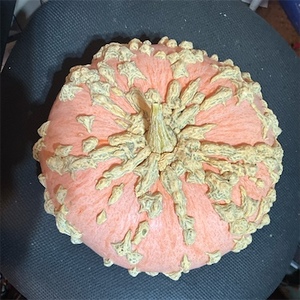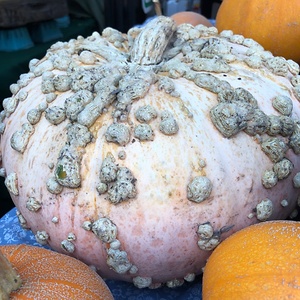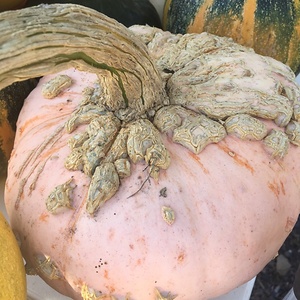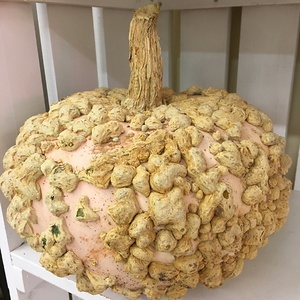

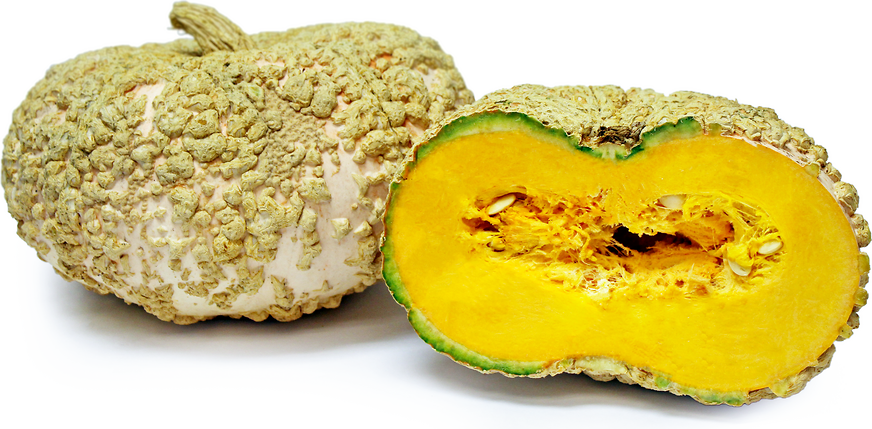
Galeux d' Eysines Squash
Estimated Inventory, lb : 0
Description/Taste
Galeux d’ Eysines squash is medium to large in size, averaging 10-20 pounds, and is round, squat, and flat on the top and the bottom. The skin transforms from green to salmon-peach when ripe and is covered in peanut-shell like protrusions. When maturing, the sugars in the flesh leech through the skin and this process is what causes the unique swelling, or wart-like bumps. As the sugar content grows, the more nodes appear on the outside of the squash and the sweeter the squash will become. The firm flesh is bright orange and moist with a medium-sized seed cavity free from the fibrous strings found in many other squash varieties. When cooked, Galeux d’ Eysines squash has a smooth, velvety texture and a sweet flavor reminiscent of sweet potato and apple.
Seasons/Availability
Galeux d' Eysines squash is available in the fall through winter.
Current Facts
Galeux d’ Eysines squash, botanically classified as Cucurbita maxima, is a rare French heirloom variety and is a member of the Cucurbitaceae family along with pumpkins and gourds. Also known as Warted Sugar Marrow, Courge Brodee Galeuse, and Peanut pumpkin, Galeux d’ Eysines squash is a vigorous and productive variety that is favored for its unique appearance and sweet, tender flesh. Originally from the Bordeaux region of France, it is commonly used in a variety of culinary applications and is also used for decorative purposes.
Nutritional Value
Galeux d’ Eysines squash contains vitamin A, vitamin C, potassium, and fiber. Its orange flesh additionally offers a significant amount of beta-carotene.
Applications
Galeux d’ Eysines squash is best suited for cooked applications such as roasting, grilling, baking, or sautéing. Its moist flesh becomes too wet when cooked with water so boiling and steaming should be avoided, and prior to consuming, the skin and bumps should be removed. The fibreless, sweet flesh of the Galeux d’ Eysines is ideal when cooked and pureed for use in soups, sauces, preserves, or pies, and it can also be cut into bite-sized pieces for roasting and served as a side with meats or fish. The seeds are also edible when roasted or baked and can be eaten alone or in a granola mix. Galeux d’ Eysines pairs well with leeks, onion, garlic, rosemary, thyme, sage, Italian parsley, nutmeg, red Russian kale, spinach, sundried tomatoes, black olives, chorizo, French bread, gruyere cheese, and feta cheese. Whole Galeux d’ Eysines squash will keep up to six months when stored at room temperature in a cool, dry, and dark place.
Ethnic/Cultural Info
The Galeux d’ Eysines is mentioned in Vilmorin-Andrieux’s famous album, Les Plantes Potagères, dating back to 1883. Its name, a nod to its unique appearance and point of origin, is believed to have originally been known as Borde Galeux d’ Eysines, which in French translates to “embroidered with scabs from Eysines.” Today the squash is still favored for its unusual appearance, and home gardeners in the United States have discovered unique ways to personalize the fruits. The young squash can be lightly etched with words or designs, and as the squash matures, it will fill in the etching with warts. This process allows gardeners to be creative with a result in having a one-of-a-kind decorative item for fall displays.
Geography/History
Galeux d’ Eysines squash is an heirloom variety which originated in Eysines, France in the nineteenth century. The Galeux d’ Eysines is thought to have then made its way to the United States in 1996 after seeds were brought back by squash expert and author Amy Goldman from the Foire aux Potirons pumpkin festival in Tranzault, France. Still a unique variety in America, it can be found when in season at farmers markets and in home gardens and is also found in Europe.
Recipe Ideas
Recipes that include Galeux d' Eysines Squash. One
| Eating Places |
|
Roasted Galeux d'Eysines Seeds |
| Bunky Cooks |
|
French Pumpkin Soup |
| Food 52 |
|
Heirloom Pumpkin Soup |







